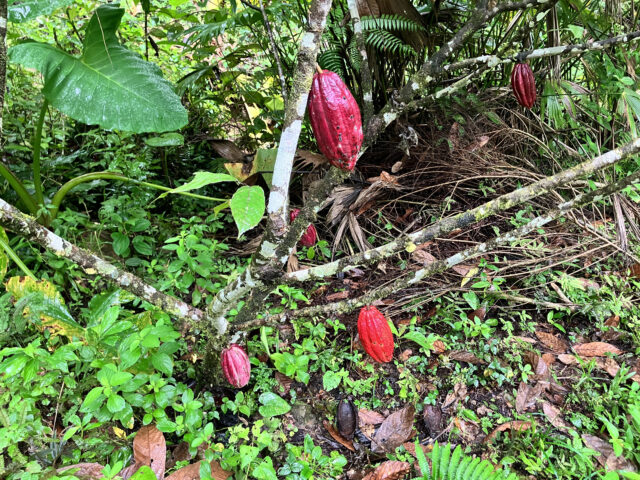
By Birgit Habermann, Praveen Kumar, Kibet Walter and Diana Mwambi
On November 14 and November 23, 2023, the Living Lab for People (LL4P) at Kaimosi Agricultural Training Centre (KATC) organized two workshops with different stakeholders to develop a vision for a Sustainable and Low-Emission Food System for Nandi County. The aim of the workshops was twofold: 1) To understand both the present image and the future vision of the Nandi County Food System citizens of different stakeholder groups and in relation to lowering emissions in the food system, and 2) To understand the meaning of low-emission food systems for the stakeholders, and factors impacting low-emission food systems in the Nandi County. The first week, it was government, NGO and private sector stakeholders, the second week farmers, farmer groups and cooperatives, representing also women and youth in agriculture. The participants were purposively selected based on a desk review to uncover key stakeholders, who are instrumental in the food system of Nandi County. These organizations and individuals were invited to participate because of their role in the food system of Nandi County.

The ILRI team facilitated the workshop and used the participatory mental modeling exercise of Fuzzy Cognitive Mapping (FCM), to understand the meaning of low-emission food systems and multiple factors impacting the low-emission food systems in Nandi County. FCM is routinely used to unpack mental models of stakeholders in social-ecological systems’ research and intervention. The mental modeling sessions using FCM helped to unpack the stakeholders’ mental models through systems mapping.
Utility of participatory approaches in unpacking food systems in the Nandi County
Deploying Participatory Approaches to explore the study objectives in the Nandi County has three significant benefits:
- Participation of diverse voices. Recent discussions in development have moved away from holistic theorization of coercive models towards more localized and participatory approaches with more emphasis on the substantive participation of citizens. There has been a parallel move towards local ‘participation’ and ‘empowerment’ in the participatory theories of evaluation. The participatory theories have often assailed the top-down approach of persuasion models on their tacit assumption that the knowledge of institutional agencies was correct and supersedes those of local populations who were either ignorant or had incorrect beliefs. In addition, the involvement of the less powerful and less frequently “heard” stakeholders may also cultivate the generation of new knowledge useful for program and organizational decision-making (referred to as practical participatory evaluation).
- Consensus building. Participatory approaches can be applied in dynamically complex situations, where multiple and diverse stakeholders influence a system. The Nandi County food system involves (but is not limited to) government agencies, private players, non-profits, farmers, farmer cooperatives, and consumers. The diversity of stakeholders invokes the need to create a more shared understanding of the dynamics and actions to improve. Discussions around cognitive maps are particularly useful where there is a high likelihood of interpersonal disagreements or there is a need for building consensus.
- Simulation of models to derive a holistic understanding of causal relationships. This is particularly beneficial when stakeholders are engaged in a participatory FCM exercise. After the cognitive maps (or models) are developed in the field, they are simulated to understand the impact of multiple factors in driving the system. Model building and simulation allow to unpack how change in multiple factors leads to change in the system as a whole. This helps in taking a “bird’s eye view” of the system, and understanding how different social, economic, technological, and behavioral sub-systems interact with each other to construct a whole system. For instance, in the Nandi County Food System, a few variables (though not limited to) that were discussed were price, fertilizers and pesticide use, and local supply chain. Simulation of these factors may uncover the role of these factors in driving the low-emissions food system of Nandi County. Simulations also ensure a relatively better understanding of factors with higher centrality and relatively higher influence in the system. The participatory theorists view FCM-based simulations as mechanics that can be used extensively to foster empowerment, emancipation, and self-determination among the stakeholders, which is often referred to as transformative participatory evaluation.
Next steps

The participatory sessions are a manifestation of the socially negotiated order which brings in consensus to all the stakeholders in addition to an increased understanding of the system as a whole. In these workshops, we wanted to understand the mental model of the invited stakeholders about the food system in Nandi county, and what a sustainable, low emission food system there should look like according to them. Hence, the workshops could serve as a group memory of their understanding of the Nandi County Food System. The sessions helped to develop the cognitive maps that reflected the mental models of the stakeholders. These maps will be leveraged to undertake simulations. The discussions and group work led us to redefine what we meant by a food system, as well as by terms such as sustainability and low-emission development. Each group, disaggregated by different characteristics, contributed their own map, with their own specific focus. The results of these workshops will be processed and analyzed in the coming months, and will then be communicated back to the same stakeholders. The cognitive maps from the FCM exercise and the associated simulation results are expected to inform the future directions of the Food Systems Initiative and the LL4P, and contribute to the planning and implementation of the next phase of the Low-Emission Eventually, these results will inform the future direction of the Living Lab for People, in terms of its strategic orientation and focus to make it a Living Lab that actually reflects the future that people Nandi County want and imagine for themselves.
See more information on the CGIAR Initiative on Low-Emission Food Systems here.
Photo credit: Birgit Habermann / ILRI; Kaimosi Agricultural Training Centre




